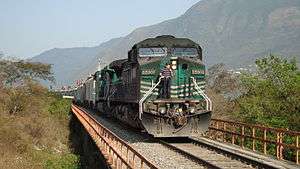El tren de la muerte
El tren de la muerte ("The Death Train") refers to a network of Mexican freight trains that are utilized by U.S.-bound migrants to more quickly traverse the length of Mexico, also known as La Bestia ("The Beast") and El tren de los desconocidos ("The train of the unknowns"). It is estimated that yearly between 400,000 and 500,000 migrants, the majority of whom are from El Salvador, Guatemala, and Honduras, ride atop these trains in the effort to reach the United States.[1][2] Although these trains (which transport products and materials including corn, cement, and minerals) are regarded as a free form of travel that allows migrants to avoid Mexico's numerous immigration checkpoints and 48 detention centers, the risks are high and many riders are left with life-altering injuries that limit their capacity to work.
As of May 9, 2014, train operators have banned the passengers from traveling by the train.[3]
Passenger risks
Many of the dangers posed by this journey result from the train itself and the process of climbing aboard and getting off moving trains. Because migrants board between 10 and 15 trains during their 1450-mile journey, which typically begins in Arriaga, Chiapas, the chances of sustaining a major injury are high before they even arrive at Lechería station in Mexico City, which serves as a sort of halfway point before the train route scatters into various directions that head closer to different points on the U.S. border.[4] Often, migrants fall asleep while riding atop trains and are jolted off and onto the tracks where many are killed instantly by decapitation, blood loss, and shock. Because accidents often occur during the night and in rural areas, victims are often not found immediately.
As with all migrant routes, those who use freight trains are subject to high rates of violence and property crime.[5] Mexican states crossed by the freight trains also experience very high rates of kidnapping.[6] Due to fears of deportation, it is believed that the actual rates of such crimes are higher than reported.
Reactions by citizens and the Mexican government
Many Central American migrants receive aid from Mexican families and community members who provide migrants with food,[7] shelter, clothes, and medicine despite their own poverty. A government support service, called Grupos Beta, was also created to help migrants. Often, Grupos Beta ride along the train tracks and visit rest stops, where they provide medical aid and information to migrants. Essentially, they are a "mobile humanitarian unit [that] does not enforce the law." That is, their purpose is not to convince migrants to not ride the trains to the border, rather their goal is simply to educate migrants about how to protect themselves throughout their journey. Apart from Grupos Beta, the Mexican Government has been criticized for its relaxed approach to the countless instances of rights violations and abuses regarding Central American migrants.[8]
In the media
"El Tren de la Muerte" has been depicted in literature, news articles, and in many films, including documentaries. One example is Which Way Home, which specifically follows the stories of children who have left their homes to come to the United States. The children range in age from 9–15 years old and are from places like Guatemala, Honduras, El Salvador, and Mexico. Like many other children, the kids in this documentary travel without an accompanying adult and their mode of transportation is "El Tren de la Muerte." These stories focus on the emotional impact of the journey as well as the physical danger. The documentary also shows what happens to children when they fail to arrive at their destination and are forced to go back to their countries of origin. Many of the other films that center around this topic feature similar stories, such as Sin Nombre, De Nadie, and El Tren de la Muerte. Most of these films have been acclaimed for bringing to light the many circumstances that migrants endure during their journey to the United States.
Sonia Nazario's best-selling novel, "Enrique's Journey", also depicts the process and obstacles of train migration. The book depicts the struggles and dangers of the journey north through the eyes of one migrant. It includes explicit details about migrants' encounters with street gangs, corrupt officials, hunger, exhaustion, discrimination, poor weather, and trains.
El Salvadorian journalist Óscar Martínez's book The Beast also depicts the hardships faced by migrants on the journey to the United States.
Other forms of media have also discussed the topic of migration and the means by which migrants travel to the United States. The presses in Central America, Mexico, and the United States cover the topic with a particular focus on the grim and unfortunate aspects of the migration process.
The train was also featured in Al Jazeera America's Borderland.
References
- Sorrentino, Joseph. "Train of the Unknowns". Commonweal. Retrieved 25 May 2013.
- "Invisible Victims: Migrants on the Move in Mexico". Amnesty International Publishers. Retrieved 25 May 2013.
- "Stowaways Are Stranded in Mexico by Train Ban". Retrieved 19 Aug 2016.
- Bridges, Levi. "Central American Migrants Face Perils on Journey North". Retrieved 3 June 2013.
- Pardinas, Juan (2008). "Los retos de la migracion en Mexico: Un espejo de dos caras" (PDF). Serie estudios y perspectivas. 99. Retrieved 3 June 2013.
- "Invisible Victims: Migrants on the Move in Mexico". Amnesty International Publications. Retrieved 3 June 2013.
- "Women of Las Patronas get fast food to migrants on Mexico's Beast train". The Guardian Newspaper. Retrieved 21 December 2016.
- "Invisible Victims: Migrants on the Move in Mexico". Amnesty International Publications. Retrieved 25 May 2013.
External links
- "Vigilarán a La Bestia con satélite, para atajar a migrantes". Telenews sitio de José Luis Galindo Sosa. Archived from the original on 2014-08-27. Retrieved 26 Aug 2014.
